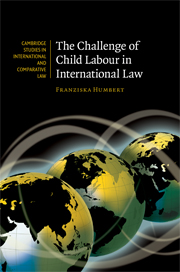Book contents
- Frontmatter
- Contents
- List of abbreviations
- Foreword
- Acknowledgements
- Introduction
- 1 The problem of child labour
- 2 The prohibition of child labour in international law
- 3 UN and ILO implementation mechanisms for the prohibition of child labour
- 4 Trade measures on child labour
- 5 Recommendations for an ILO–WTO enforcement regime
- Concluding summary
- Bibliography
- Index
- CAMBRIDGE STUDIES IN INTERNATIONAL AND COMPARATIVE LAW
Concluding summary
Published online by Cambridge University Press: 20 February 2010
- Frontmatter
- Contents
- List of abbreviations
- Foreword
- Acknowledgements
- Introduction
- 1 The problem of child labour
- 2 The prohibition of child labour in international law
- 3 UN and ILO implementation mechanisms for the prohibition of child labour
- 4 Trade measures on child labour
- 5 Recommendations for an ILO–WTO enforcement regime
- Concluding summary
- Bibliography
- Index
- CAMBRIDGE STUDIES IN INTERNATIONAL AND COMPARATIVE LAW
Summary
This section provides a summary of results reached during the course of this work. An epilogue putting the work into the broader context of the current trends in public international law and suggesting further questions for research completes this work.
SUMMARY OF RESULTS
This work has explored whether the existing UN and ILO implementation systems regarding the international prohibition of child labour should be complemented by a legal framework providing for trade measures. It asks whether trade rules should be used to combat child labour and how such a linkage should be framed in international law. With regard to the trade and labour debate, the work focuses on arguments relating to the effectiveness of social clauses and addresses the issue of coherence in international law.
The work starts with presenting the problem of child labour. Not all work done by children is intolerable. The main institutions dealing with child labour differentiate between light work or beneficial work on the one hand and child labour or exploitative child labour on the other hand. Child labour can be defined as the denial of the right to education and of the opportunity to reach full physical and psychological development. There is still widespread child labour today – in the larger group of children aged five to seventeen, 218 million children can be regarded as child labourers. The main causes of child labour are poverty as well as governmental and societal attitudes.
- Type
- Chapter
- Information
- The Challenge of Child Labour in International Law , pp. 386 - 389Publisher: Cambridge University PressPrint publication year: 2009

